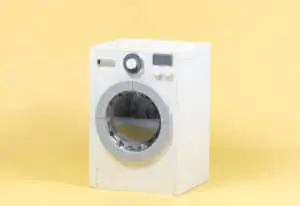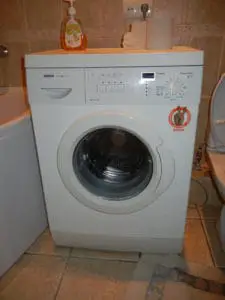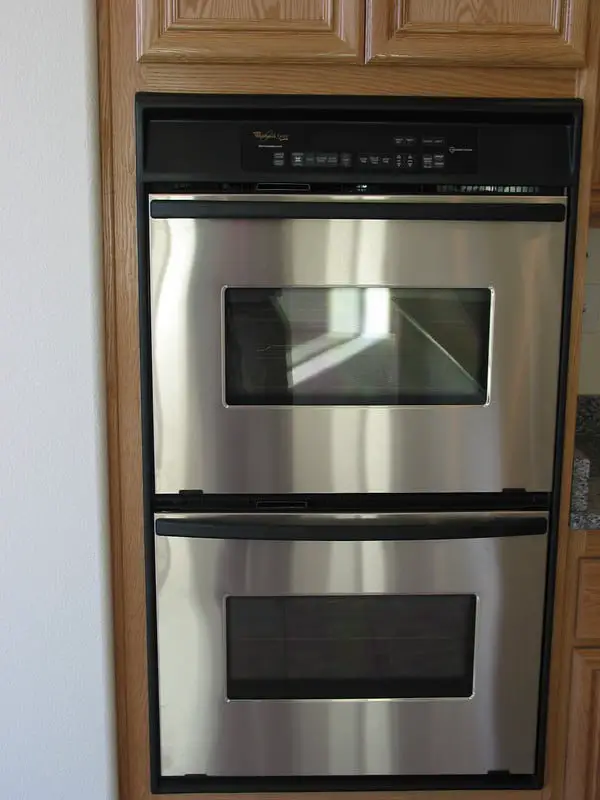If your home is cramped up, then you will probably be trying to figure out the best way to squeeze a few must-have appliances and other items close together to save as much space as possible.
You’ve probably thought of bringing your washer into the kitchen area.
Because ovens and washers are almost the same sizes in most cases, you are probably trying to figure out the most practical way to install them adjacent to each other.
So, Can You Put A Washing Machine Next To An Oven?
In one word – No. it may make sense on some occasions such as when the electrical socket (capable of supporting these two appliances at the same time) is located at a convenient spot to serve these two. But the whole arrangement may not give you the best experience you deserve. Also, a lot of people wouldn’t be perfectly okay with doing laundry in the same place they prepare their meals. The best thing about washers is that they can be installed outdoors – can be put in the garage and still deliver – so, you don’t really squeeze them in the kitchen regardless of how compact your living is.
Two Reasons Why A Washer And Oven Shouldn’t Be Adjacent To Each Other

1. Water and electricity don’t mix
You can install the dishwasher right next to an oven (most kitchens feature them together, by the way).
It is easy to be tempted to have a similar arrangement with your washing machine and oven.
However, it is important to note that dishwashers are engineered a little differently compared to dishwashers.
Manufacturers are aware their dishwashers normally end up in the kitchen where they need to work close to ovens.
As such, they often engineer their dishwashers to be as leak-proof as possible even in their hot water feeder pipes.
Conversely, the makers of washing machines don’t envision these appliances working in tandem with kitchen appliances.
Also, washing machines use far more water than dishwashers, so spills and other water-related malfunctions are likely to occur.
The fact that they need two feeder pipes (one with hot water and the other with cold water) adds to the complication
Water and electricity are a deadly combination – we all know the outcome if you get in the mix.
So, to protect yourself as well as other occupants of your home, you should never place your washer and oven close to each other. If you must, then consider investing in an insulation board, which you can put in between the two appliances.
2. The Heat Issue
Whilst opening your oven door and checking your food – if you get blasted by searing plumes of smoke and heat you may have a serious issue! This is more likely to happen if the oven is installed very close to another large appliance such as a washing machine.
Most ovens feature traditional thermostats that serve to control the operating temperature of the device. If the oven is prone to overheating on the outer panels, the most probable reason is a problematic thermostat.
Yet thermostats only work perfectly in absence of undue temperature variations lest they give false interpretations and cause overheating.
Therefore, if the washer installed close to the oven generates significant heat, it can produce wrong readings on the oven’s thermostat.
When your oven heats up erratically it can make your dishes either overcook or even get out burnt. That means the only suitable endpoint for your preparation would be the garbage bin rather than the dinner plate.
If this is the problem you are facing, we’d advise you to separate your oven and washer.
The problem may manifest itself via various avenues:
Thermostat-sensing bulb
Most ovens come with a bulb designed to sense the thermostat, usually placed at the back left side of the appliance but can sometimes be found at the rear.
If you install the washer and the oven too close in such a way that the washer interferes with the bulb’s function, the thermostat will have a hard time determining the right temperatures for your oven, causing it to malfunction and overheat.
Foam and grime
In the long run, depending on your level of care, foam mixed with water and detergents may collect on the surface of the washer – some of it may find its way to the oven.
This, combined with grime from food may form a layer that can affect the smooth functioning of the thermostat.
However, this is probably the easiest to rectify – a simple wipe on the thermostat is enough to clean and solve the overheating issue.
Oven-vent
For an oven to heat uniformly, an air cycle needs to be established in the cavity.
Hot air is normally expelled via a top or sideway vent, allowing cold air to enter the cavity from beneath.
This cycle can be hampered if the vents are blocked by a nearby washer, especially if the manufacturer of the oven recommends a reasonable clearance on the sides of the appliance.
Oven fan
The job of the oven fan is to force into the cavity and distribute heat evenly for better cooking.
The heating element installed around the fan equalizes the inner temperature, heating every tray or level inside the cavity equally.
Most ovens feature a fan-forced symbol in form of a spinning fan enclosed in a circle.
If the oven is installed close to a washer or other items that may limit the smooth flow of air into the fan and eventually into the cavity, the oven may overheat.
One Possible Solution – Take It To The Bathroom

Related: Washing Machine Outlet Boxes Guide
If the space in your kitchen is tight, take a tip or two from the Europeans – take your washer in the bathroom.
However, there are a few tough rules on that arrangement.
First, you will need to comply with your local regulations.
In most cases, the washer has to be not less than 3 meters away from your shower or e bath or shower.
You will also need to hire a qualified electrician to check whether the appliance is plugged into the socket is properly and is RCD protected.
Related: Is It Better To Have A Double Oven Or Two Single Ovens?
Conclusion
Can you put a washing machine next to an oven? No. Unlike dishwashers that work in harmony with most ovens while tucked in the cabinet, a washer is a little bit sophisticated. Washers require two feeder water pipes, one with cold and hot water in the other. You are going to have a hard time installing this infrastructure under your kitchen cabinets. If you do, then they are more likely to be marred with malfunctions.
- Washing machines use far more water than dishwashers, so spills and other water-related malfunctions are likely to occur.
- The washer will bring a lot of water in the kitchen – the presence of water and high voltage electricity needed to power both the oven and the washer can be dangerous
- Water and electricity are a deadly combination – we all know the outcome if you get in the mix.
- So, to protect yourself as well as other occupants of your home, you should never place your washer and oven close to each other
- If you must, then consider investing in an insulation board, which you can put in between the two appliances.
- Whilst opening your oven door and checking your food – if you get blasted by searing plumes of smoke and heat you may have a serious issue! This is more likely to happen if the oven is installed very close to another large appliance such as a washing machine.
- Most ovens feature traditional thermostats that serve to control the operating temperature of the device.
- If the oven is prone to overheating on the outer panels, the most probable reason is a problematic thermostat.
- Thermostats only work perfectly in absence of undue temperature variations lest they give false interpretations and cause overheating.
- Therefore, if the washer installed close to the oven generates significant heat, it can produce wrong readings on the oven’s thermostat.
- When your oven heats up erratically it can make your dishes either overcook or even get out burnt.
- That means the only suitable endpoint for your preparation would be the garbage bin rather than the dinner plate.
The problem may manifest itself via various avenues:
- If you install the washer and the oven too close in such a way that the washer interferes with the bulb’s function, the thermostat will have a hard time determining the right temperatures for your oven, causing it to malfunction and overheat.
- Depending on your level of care, foam mixed with water and detergents may collect on the surface of the washer – some of it may find its way to the oven.
- The air cycle needed in ovens to cook can be hampered if the vents are blocked by a nearby washer, especially if the manufacturer of the oven recommends a reasonable clearance on the sides of the appliance.
- If the space in your kitchen is tight, take a tip or two from the Europeans – take your washer in the bathroom. However, there are a few tough rules on that arrangement.
- You will need to comply with your local regulations. In most cases, the washer has to be not less than 3 meters away from your shower or bathtub.

